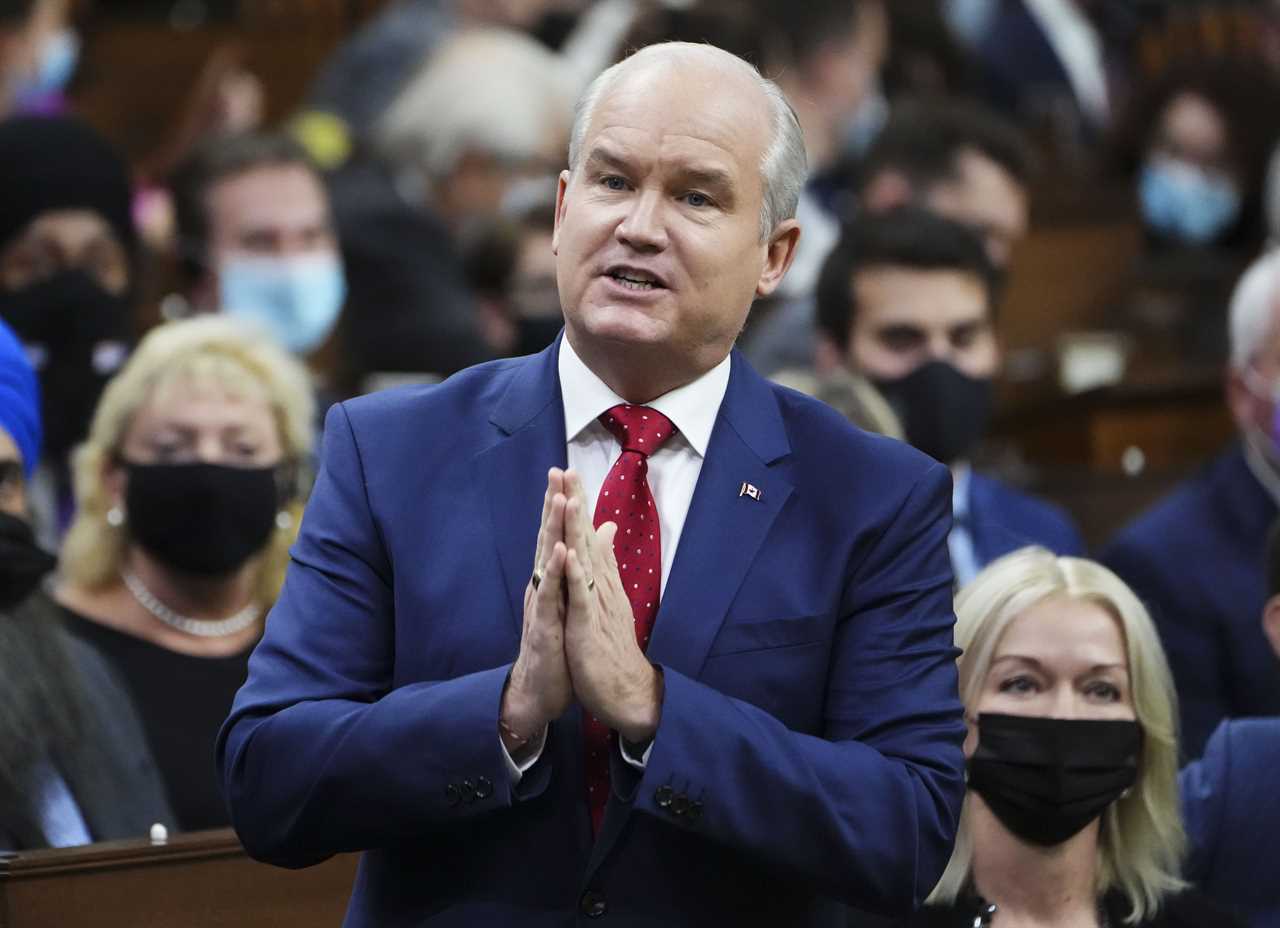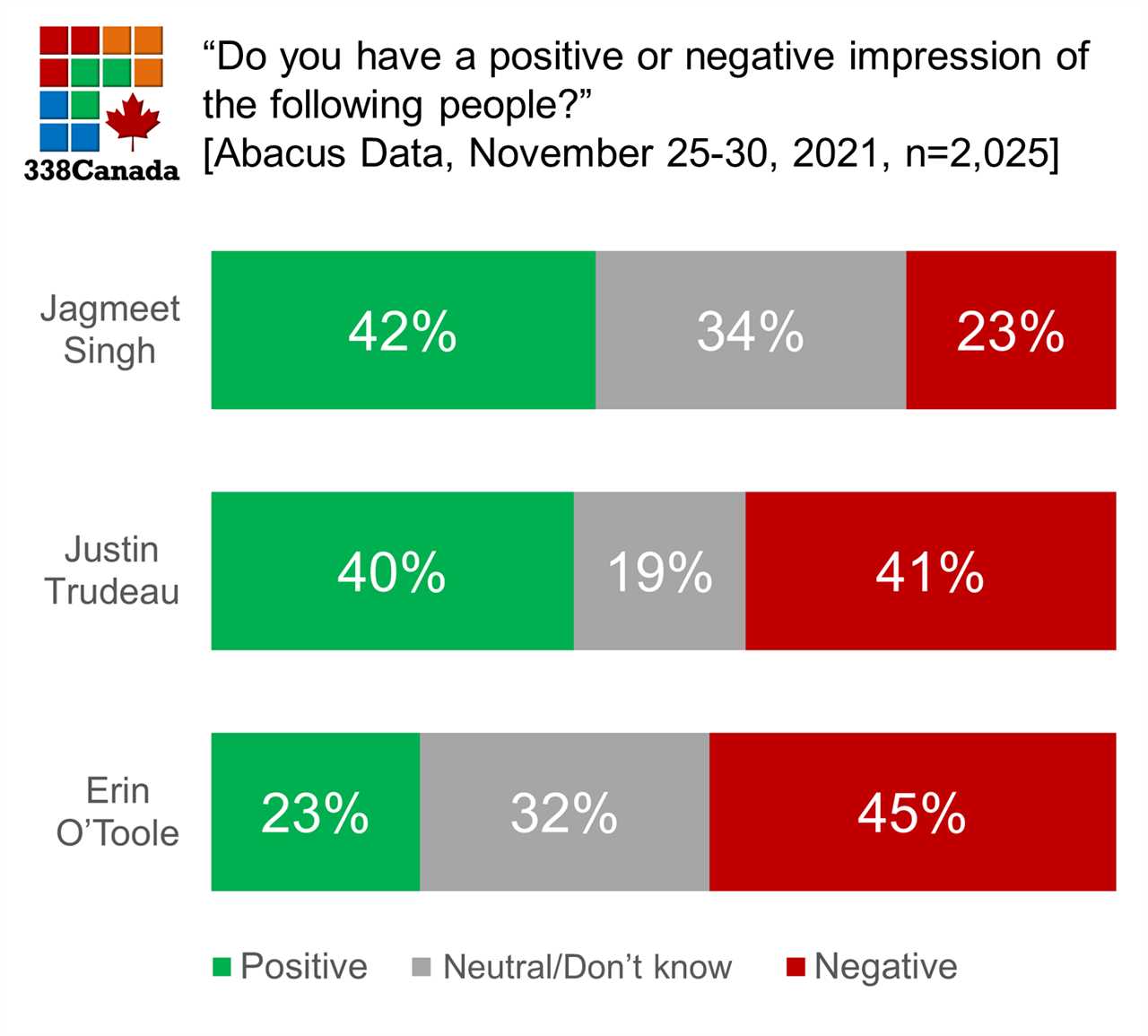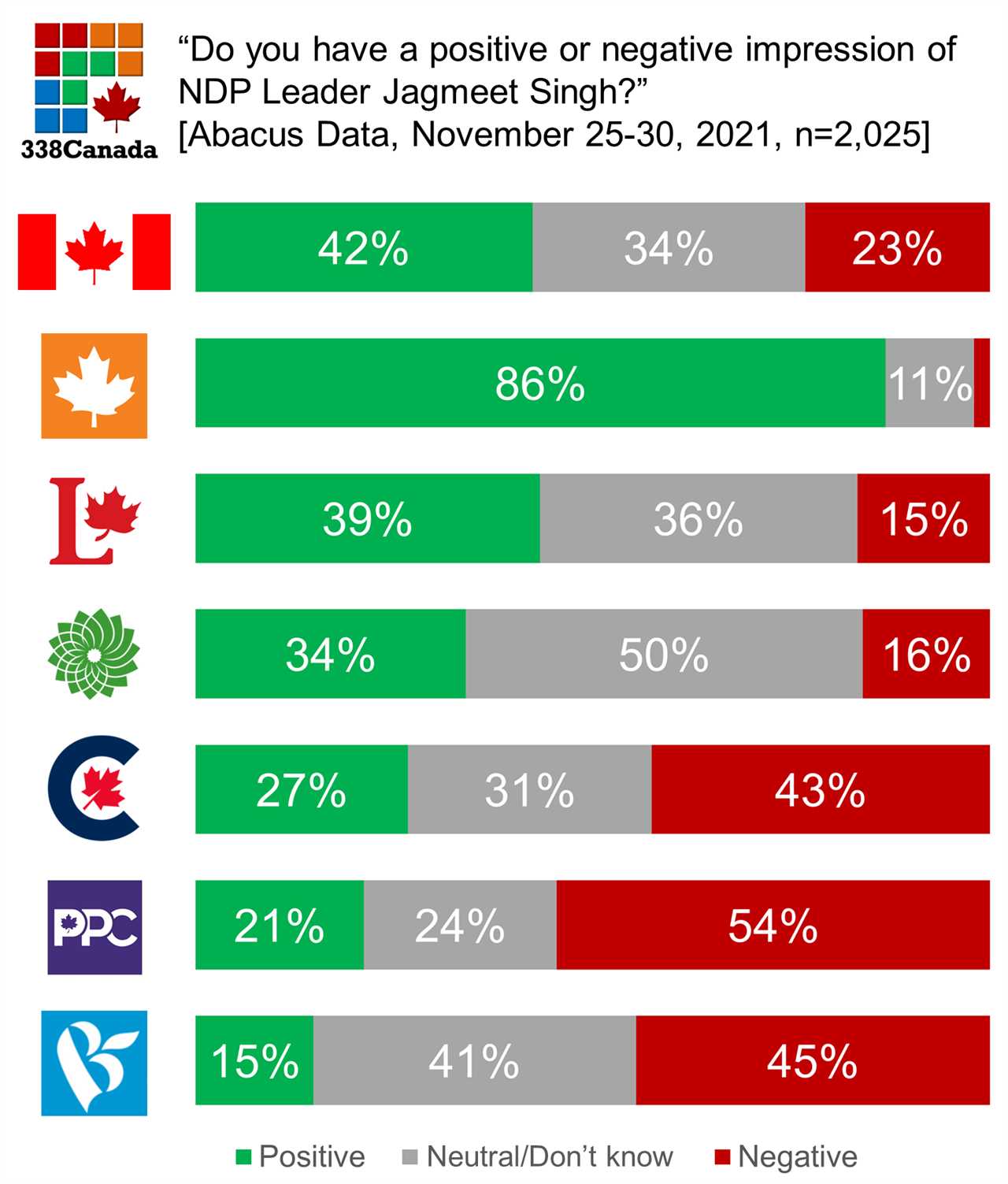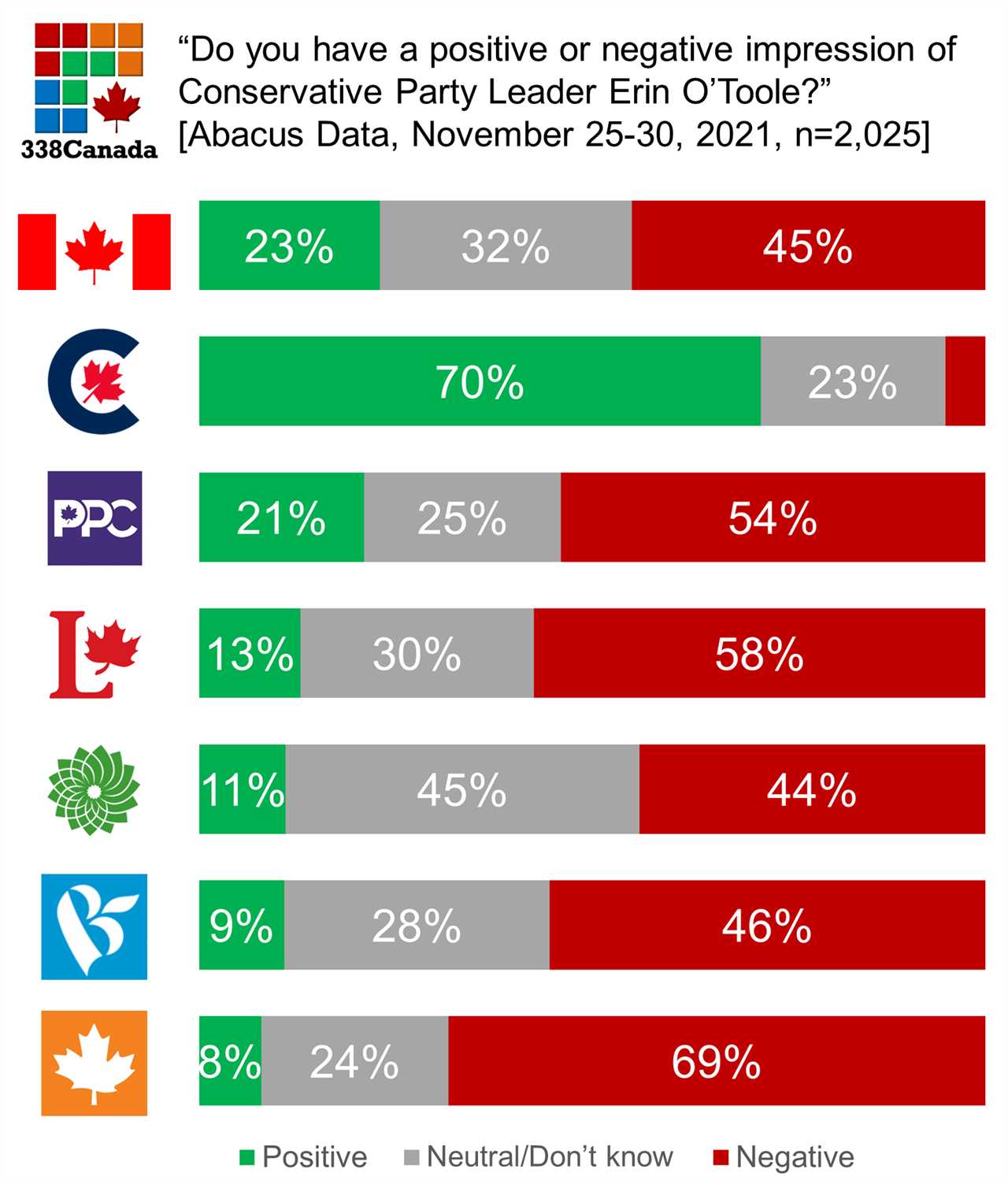
The first session of the 44th Parliament (finally) began last week, almost two months after September’s general election. While voting intentions have (unsurprisingly) remained generally stable during that time, this long pause in parliamentary hostilities does not appear to have benefited Conservative leader Erin O’Toole, whose party has been embroiled in internal squabbles since its election defeat. To wit, a new poll released by Abacus Data shows that impressions of the Conservative leader have fallen back to their pre-election levels.
To the question: “Do you have a positive or negative impression of the following federal party leaders?”, O’Toole’s favourable responses nosedived: 23 per cent positive against 45 per cent negative, for a net score of -22, the worst score among major federal party leaders.
At the start of the federal campaign in August, Abacus had measured O’Toole’s impression at a similar net score of -21. However, as the campaign progressed, the CPC leader’s perception improved substantially, until it reached a score of -10 in mid-September. In hindsight, his improving personal numbers were a leading indicator of his party’s growing support, which would peak in early September only to fall back after the leaders’ debates.
Here are the numbers for the three main party leaders:

While the Prime Minister’s approval rating has slightly eroded since the election, Abacus did not measure any dramatic shifts. With 40 per cent positive and 41 per cent negative impressions, Justin Trudeau enters this new Parliament with a net score of -1 in the Abacus poll, down from +5 at the end of the campaign.
Only NDP leader Jagmeet Singh fares well, with 42 per cent positive and 23 per cent negative, a net score of +19. Nonetheless, these numbers remain similar to those measured at the end of the campaign last September, and the challenge for Singh in this 44th Parliament will be to find a way to turn this positive perception into actual support at the polls, something he failed to accomplish in both the 2019 and 2021 elections. Federal leaders who are given a third kick at the can are few and far between, but it appears that Singh is firmly in the saddle as leader of the NDP, at least in the short to medium term.
Let’s take a look at these leaders’ approval ratings based on respondents’ voting intentions. Not surprisingly, the Prime Minister’s best numbers come from Liberal voters. Eighty-seven per cent of this group of voters have a positive impression of Justin Trudeau. Among voters of the other parties, one-quarter of Bloc Québécois and NDP voters say they have a good impression of Justin Trudeau, but a majority of Bloc Québécois (61 per cent), Green (64 per cent), Conservative (78 per cent) and People’s Party (84 per cent) voters have a negative impression of the Prime Minister.

In the case of Jagmeet Singh, he registers high support among his party’s voters (in similar proportions to Trudeau among Liberals), with 86 per cent of positive impressions. Among supporters from other parties, there is a significant split: on the one hand, there are Liberals and Greens, among whom Singh registers net scores of +24 and +18 respectively; on the other hand, the NDP leader is mostly viewed negatively by Conservative (-16), Bloc (-30) and PPC (-33) voters.

What about Conservative leader Erin O’Toole? Among his party’s supporters, 70 per cent still hold a positive impression of him, a proportion slightly lower than for Trudeau and Singh among their respective constituencies, but higher than what Abacus Data had measured last spring (62 per cent). However, we note that the Conservative leader scores poorly among voters of other parties: only 8 to 13 per cent of NDP, Bloc, Liberal and Green voters view O’Toole favourably.

Even among Maxime Bernier’s People’s Party of Canada (PPC) voters, O’Toole receives a dismal net score of -33 (21 per cent positive impression and 54 per cent negative impression).
These low levels of appreciation across party lines suggest that the Conservative Party, while winning the popular vote in the last two general elections (by one point over the Liberals), is still hindered by limited potential for growth, even with a leader who is perceived as more centrist than his predecessors. Given that O’Toole must find a way to expand his voter base if he is to have any hope of winning the next election (if his party keeps him in office until then, of course), how should he and his team interpret this data?
Some Conservative strategists may believe that trying to bring PPC voters back into the fold would give the Conservative party a chance to return to power (Maxime Bernier’s party received 5 per cent of the vote last September). However, this strategy could prove to be a dead end for O’Toole: Although the sample of PPC voters in this survey is small, the differences between positive and negative impressions of the Conservative leader are well beyond a reasonable margin of error. Most PPC voters view O’Toole unfavourably, and so if O’Toole were to court Maxime Bernier’s voters, this strategy might convince only a small number of them to switch parties, while further pushing away swing voters, among those many might be looking for change in government after a decade of Trudeau in power.
We shall see whether O’Toole can improve his numbers now that Canadians are finally able to see him in action in the House of Commons.
The post 338Canada: O’Toole’s numbers fall back to pre-election levels appeared first on Macleans.ca.
-------------------------------
By: Philippe J. Fournier
Title: 338Canada: O’Toole’s numbers fall back to pre-election levels
Sourced From: www.macleans.ca/politics/ottawa/338canada-otooles-numbers-fall-back-to-pre-election-levels/
Published Date: Fri, 03 Dec 2021 15:28:29 +0000
Read More
Did you miss our previous article...
https://badpoliticians.com/world-politics/the-new-covid19-travel-rules-cause-some-confusion-freeland-will-provide-a-budget-update
 UK PoliticsWorld PoliticsVideosPrivacy PolicyTerms And Conditions
UK PoliticsWorld PoliticsVideosPrivacy PolicyTerms And Conditions
